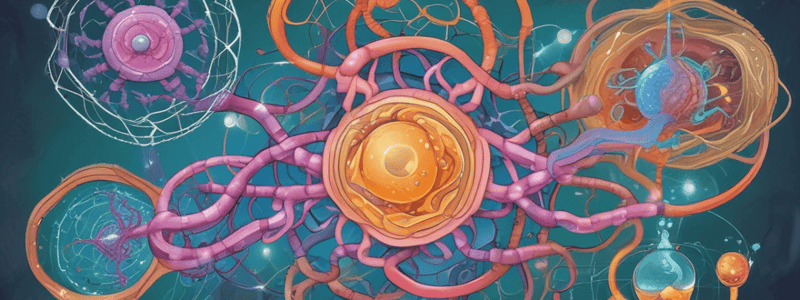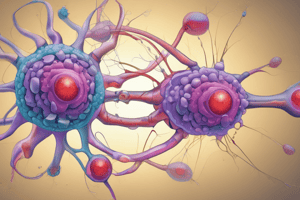Podcast
Questions and Answers
What is the primary mechanism by which lipophilic hormones interact with their receptors?
What is the primary mechanism by which lipophilic hormones interact with their receptors?
- By diffusing through the plasma membrane and binding to receptors in the cytosol or nucleus (correct)
- By being converted into a secondary messenger that interacts with receptors on the plasma membrane
- By generating a secondary messenger that interacts with intracellular receptors
- By binding to receptors on the plasma membrane
Which type of hormone is synthesized as a precursor molecule and then processed and secreted upon a physiologic cue?
Which type of hormone is synthesized as a precursor molecule and then processed and secreted upon a physiologic cue?
- Catecholamines
- Insulin (correct)
- Thyroid hormones
- Steroid hormones
What is the role of the ligand-receptor complex in hormone signaling?
What is the role of the ligand-receptor complex in hormone signaling?
- It acts as a secondary messenger
- It generates a secondary messenger (correct)
- It is the hormone itself, which is the first messenger
- It is the intracellular messenger in lipophilic hormone signaling
Where do polypeptide/protein hormones and catecholamines bind to their receptors?
Where do polypeptide/protein hormones and catecholamines bind to their receptors?
How do hormones that bind to surface receptors communicate with intracellular metabolic processes?
How do hormones that bind to surface receptors communicate with intracellular metabolic processes?
What is the characteristic of hormones derived from cholesterol?
What is the characteristic of hormones derived from cholesterol?
What is the primary mechanism by which water-soluble hormones interact with their receptors?
What is the primary mechanism by which water-soluble hormones interact with their receptors?
What is the effect of the interaction between lipophilic hormones and their receptors?
What is the effect of the interaction between lipophilic hormones and their receptors?
What is the immediate result of angiotensin-converting enzyme action on angiotensin I?
What is the immediate result of angiotensin-converting enzyme action on angiotensin I?
What is the function of C-peptide in the context of insulin?
What is the function of C-peptide in the context of insulin?
Where are catecholamines stored before release into the circulation?
Where are catecholamines stored before release into the circulation?
What is the characteristic of steroid hormones and 1,25(OH)2-D3?
What is the characteristic of steroid hormones and 1,25(OH)2-D3?
What is the effect of angiotensin II on renin release?
What is the effect of angiotensin II on renin release?
What is the site of pro-insulin processing to form mature insulin?
What is the site of pro-insulin processing to form mature insulin?
What is the function of renin in the renin-angiotensin-aldosterone system?
What is the function of renin in the renin-angiotensin-aldosterone system?
What is the characteristic of polypeptide hormones, such as insulin?
What is the characteristic of polypeptide hormones, such as insulin?
What is the primary characteristic of hormone concentrations in the extracellular fluid?
What is the primary characteristic of hormone concentrations in the extracellular fluid?
Which of the following is a classification method for hormones?
Which of the following is a classification method for hormones?
What is the characteristic of hormone action in terms of affected cell types?
What is the characteristic of hormone action in terms of affected cell types?
Which type of hormone is synthesized from cholesterol?
Which type of hormone is synthesized from cholesterol?
What is the primary mechanism of hormone action in terms of distance?
What is the primary mechanism of hormone action in terms of distance?
What is the characteristic of hormone receptors in terms of location?
What is the characteristic of hormone receptors in terms of location?
What is the characteristic of hormone action in terms of signal mediation?
What is the characteristic of hormone action in terms of signal mediation?
What is the characteristic of hormone synthesis in terms of protein and peptide hormones?
What is the characteristic of hormone synthesis in terms of protein and peptide hormones?
What is the function of Na+-K+-ATPase-dependent thyroidal I− transporter in the synthesis of T3 and T4 hormones?
What is the function of Na+-K+-ATPase-dependent thyroidal I− transporter in the synthesis of T3 and T4 hormones?
Which of the following statements about T3 synthesis is true?
Which of the following statements about T3 synthesis is true?
What is the primary component of thyroglobulin?
What is the primary component of thyroglobulin?
What is the role of thyroglobulin in the synthesis of T3 and T4 hormones?
What is the role of thyroglobulin in the synthesis of T3 and T4 hormones?
What is the characteristic of peptide hormones such as insulin and parathyroid hormone?
What is the characteristic of peptide hormones such as insulin and parathyroid hormone?
What is the name of the protein precursor from which several hormones are derived?
What is the name of the protein precursor from which several hormones are derived?
What is the process by which T4 is converted to T3 in peripheral tissues?
What is the process by which T4 is converted to T3 in peripheral tissues?
What is the ratio of iodide in thyroid to iodide in serum regulated by?
What is the ratio of iodide in thyroid to iodide in serum regulated by?
Which of the following hormones is a lipophilic hormone?
Which of the following hormones is a lipophilic hormone?
What is a characteristic of Group II (Class II) hormones?
What is a characteristic of Group II (Class II) hormones?
Which of the following hormones is a peptide hormone?
Which of the following hormones is a peptide hormone?
What is the effect of binding to a protein on the half-life of a lipophilic hormone?
What is the effect of binding to a protein on the half-life of a lipophilic hormone?
Which of the following hormones is a steroid hormone?
Which of the following hormones is a steroid hormone?
What is the biological form of a lipophilic hormone?
What is the biological form of a lipophilic hormone?
Which group of hormones includes those that are water-soluble and have a peptide structure?
Which group of hormones includes those that are water-soluble and have a peptide structure?
Why do lipophilic hormones need to associate with plasma transport or carrier proteins in the circulation?
Why do lipophilic hormones need to associate with plasma transport or carrier proteins in the circulation?
Flashcards are hidden until you start studying
Study Notes
Hormone Classification and Mechanisms
-
Hormones are classified into two groups based on their solubility and receptor location:
- Group I (Class I): Lipophilic hormones that bind to intracellular receptors, have a shorter half-life, and are transported by plasma transport proteins.
- Group II (Class II): Water-soluble hormones with a peptide structure, bind to surface receptors, and have a shorter half-life.
-
Hormones are synthesized and modified in various ways, such as:
- Hormones derived from cholesterol are synthesized in their final form and secreted immediately.
- Catecholamines are synthesized in their final form and stored in producing cells.
- Hormones like insulin are synthesized as precursor molecules, processed, and secreted upon a physiologic cue.
Hormone Structure and Properties
-
Hormones are synthesized from various sources, including:
- Cholesterol (e.g., glucocorticoids, mineralocorticoids, androgens)
- Amino acids (e.g., tyrosine derivatives, tryptophan derivatives)
- Protein/peptides of various sizes (e.g., insulin, parathyroid hormone, thyrotropin-releasing hormone)
-
Hormones have specific structures and properties, such as:
- Lipophilic steroid hormones (e.g., estrogen, progesterone, thyroid hormone) interact with intracellular receptors, directly affecting gene transcription.
- Water-soluble hormones (e.g., catecholamines, insulin) bind to surface receptors, generating a secondary messenger or signal.
Hormone Mechanisms and Action
-
Hormones bind to specific receptors, triggering a response:
- Lipophilic hormones bind to intracellular receptors, influencing gene transcription.
- Water-soluble hormones bind to surface receptors, generating a secondary messenger or signal.
- The ligand-receptor complex acts as an intracellular messenger, affecting various cellular functions.
-
Hormones can have multiple effects on different cell types, and multiple hormones can affect a single cell type.
Specific Hormones and Systems
-
Insulin:
- Synthesized as a preprohormone in pancreatic beta cells.
- Processed into pro-insulin, then mature insulin and C-peptide.
- Released in response to elevated blood glucose levels, regulating metabolic effects.
-
Renin-Angiotensin-Aldosterone System:
- Activated when blood pressure decreases.
- Angiotensinogen is converted into angiotensin I, then angiotensin II, which stimulates aldosterone production, leading to Na+ retention, volume expansion, and increased blood pressure.
-
Thyroid Hormones:
- Synthesized from tyrosine in the thyroid gland.
- Iodinated to form T4 and T3, with 70% of iodide in thyroglobulin existing in inactive precursors and 30% in metabolically active forms.
- T3 is produced in peripheral tissues through deiodinase activity.
Studying That Suits You
Use AI to generate personalized quizzes and flashcards to suit your learning preferences.



